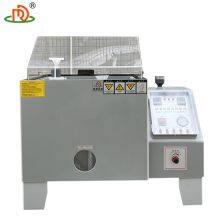Model | DR-H304-90(120、200) |
Internal Size (W*D*H) | 900x600x500mm |
External Size (W*D*H) | 1410x880x1280mm |
Chamber material | P.V.C rigid plastic plate, thickness 8mm |
Sample tray | Diameter 10mm glass fiber rod, anti-rust V-shape plastic steel to make sure sample in 15~30 degree inclined |
Temperature Range | Room temperature ~ 55℃ |
Temperature Fluctuations | ≤±0.5℃ |
Temperature Uniformity | ≤±2℃ |
Temperature Precision | ±1℃ |
Spraying method | Continuous and Periodic spray type |
Test Chamber Temperature | Salt Spray Method (NSS ACSS)35±1℃ |
Saturated air Barrel Temperature | Salt Spray Method (NSS ACSS)47±1℃ |
Brine Temperature | 35℃±1℃ |
Spray Quantity | 1.0~2.0 ml / 80cm2 / hr |
PH value | Salt Spray Method (NSS ACSS6.5~7.2) |
Lab Volume | 108L |
Brine Tank Capacity | 25L |
Multiple Safety Protection Devices | Current discharge protection, over pressure protection, over temperature protection, over load fuse protection |
Accessories | Testing Salt/ Measuring tank/Nozzle Equipment x 1 set |
Air source | 1HP Air pump (provided by buyer) |
Steel products undergo a complex electrochemical corrosion process during salt spray testing, which usually results in the following corrosion phenomena:
Uniform corrosion
Description of the phenomenon: reddish-brown rust will appear uniformly on the surface of steel, initially as tiny corrosion spots, and then gradually expand into flakes.
Mechanism: In the salt spray environment, iron atoms on the steel surface react with chloride ions to form soluble iron ions, which then react with oxygen to generate iron hydroxide, and ultimately dehydrate to form iron trioxide, i.e. rust.
Pitting
Description of the phenomenon: Small, deep corrosion pits are formed on the steel surface, and these pits are usually surrounded by shallower corrosion areas.
Mechanism: Chlorine ions will destroy the passivation film on the steel surface, so that the potential of the local area is lowered, the anode, while the surrounding area becomes the cathode, forming a microcell. Iron atoms in the anodic region dissolve into solution and subsequently combine with chloride ions to form ferrous chloride, which is further oxidized to form iron hydroxide and rust.
Crevice Corrosion
Description of the phenomenon: Corrosion is accelerated in areas such as crevices in steel components, around gaskets or nuts, forming localized corrosion pits.
Formation mechanism: The concentration of chloride ions within the crevice will increase due to water evaporation, leading to localized acidification, destroying the passivation film and causing steel to corrode within the crevice.
Stress corrosion cracking
Description of the phenomenon: For steel components subjected to stress, cracks along grain boundaries or through the grain may appear during salt spray testing, which may lead to fracture of the component in severe cases.
Formation mechanism: Under the combined effect of tensile stress and chloride ions, the dislocation motion in steel is blocked and the bonding between atoms is weakened, leading to crack initiation and expansion.

Send Inquiry to This Supplier
You May Also Like
-
Electronic Component Humidity Chamber - IPC/JEDEC J-STD-020 Moisture SensitivityUS$ 3999 - 9999MOQ: 1 Set
-
Battery Humidity Chamber - ISO 23274 Cycle Life SimulationUS$ 3999 - 9999MOQ: 1 Set
-
IEC 60068-2-78 Humidity Chamber - Combined Temperature/Humidity TestingUS$ 3999 - 9999MOQ: 1 Set
-
Humidity Environmental Tester Hamber - Material EnduranceUS$ 3999 - 9999MOQ: 1 Set
-
High-Humidity Environmental Chamber - 98%RH Dew Point ControlUS$ 3999 - 9999MOQ: 1 Set
-
Low-Temperature Humidity Chamber - -40℃ to +150℃ Temperature RangeUS$ 3999 - 9999MOQ: 1 Set
-
Three-Zone Humidity Chamber - Independent Temperature/Humidity ControlUS$ 3999 - 9999MOQ: 1 Set
-
Fast-Response Humidity Tester - 5%RH/min Humidity Change RateUS$ 3999 - 9999MOQ: 1 Set
-
Automotive Electronics Humidity Chamber - GM 9537P Humidity TestingUS$ 3999 - 9999MOQ: 1 Set
-
Automotive Electronics Humidity Chamber - GM 9537P Humidity TestingUS$ 3999 - 9999MOQ: 1 Set










